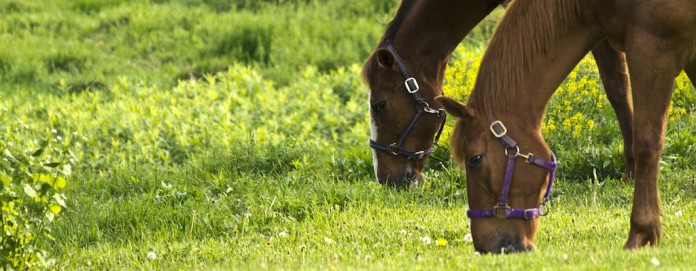Horses do best when they are allowed to graze, so maintaining good pastures for horses is an important management practice. Providing pastures for horses is also a great way to allow them to get exercise while furnishing them with the nutrients they need.
Acreage
The amount of pasture required for a horse varies depending on the size and age of the horse, pasture species, amount of supplemental feed provided and soil fertility. A mature horse will consume about 2 percent of its body weight in dry matter per day. Therefore, horses should be provided at least 1-2 acres of pasture per horse to graze.
Grasses
Horses generally prefer grasses, so pastures should consist of mainly grasses or grass/legume mixtures. Sound pasture management is essential to keep the desired grass species persistent and productive, and weed infestations low to none. Horse pastures can be improved by soil testing and adding lime and fertilizer as tests results recommend. But some form of rotational grazing is also desirable.
Overgrazing
It is not unusual to see horse pastures that are either overgrazed or under grazed, trampled and unproductive. While the basic problem is inadequate pasture area, a lack of grazing management can also be a problem.
Horses are more selective than cattle and are notorious spot grazers. In addition, they bite off forage very closely to the ground. The result is that some areas in a pasture are heavily grazed while others are left untouched. If horses are allowed to continue this grazing practice too long, it can hurt plant vigor and forage stands in the grazed spots, while wasting forage in the ungrazed areas.
Rotation
Moving horses from one area in the pasture to another can provide the following benefits:
- Increase the vigor of pasture plants by resting them on a regular basis.
- Achieve more even utilization of the forage produced.
- Minimize hoof damage and reduce parasite problems.
- Cattle and horses may be grazed together because cattle will reduce the effects of spot grazing.
Fencing
Horses are color blind. Using electric fencing, either coated high tensile or electrified tapes, is safe to use in small paddocks to limit a horse’s access so that they will better utilize and graze the area. But if horses are not used to electrified wire, make sure that you condition them by initially exposing them to the high tensile or tape before turning them loose in the field to prevent injuries.
Even 1-to 2-acre paddocks can be rotationally grazed by using movable electric fencing. This does require more labor to move water tubes, etc. but is totally worth it to better utilize your forages for your horses.
Clipping pastures
Once the horse or horses are moved to another area of the pasture, it may need to be clipped to even out the overgrazed and under-grazed areas in the field and keep the forage plants young and tender. Clipping pastures can also keep weed infestation low.
Other tips
Dragging pastures throughout the year after horses have been moved scatters manure, and will reduce parasite problems. Pastures used for horses should be well drained, free of holes, and contain no poisonous plants that might cause them illness.
Finally, horses need access to shade, plenty of clean fresh water, salt and a basic mineral mixture. Horses do not normally bloat on pasture but they can founder on extremely lush pasture if they are not acclimated to it and are allowed to overeat.
Keep your horse paddocks productive by moving the animals around and rotationally grazing.













